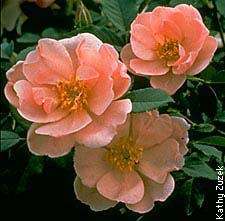 FO-06953
FO-06953Kevin Stroom, Jody Fetzer, and Vera Krischik
Roses are very popular landscape plants grown for their beauty. Roses are susceptible to several insects and diseases which reduce flower growth and quality as well as frustrate rose gardeners. In general, these insects do not kill the plant, but may stunt or kill parts, affect flowering, or cause aesthetic damage. Learning the proper care of roses and management of pest problems increases your success in growing a beautiful rose bush.
 Photo 1: Healthy rose blossoms. |
Next, select a proper site. Make sure that soil and light requirements are met and that the roses are planted at the correct depth. After planting, appropriate long-term maintenance is important. Follow the instructions found on the tag for water and fertility requirements, and provide a mulch around the base of the plants. See Extension publication Culture of Garden Roses, FS-1105, for more information on cultivation.
Management of insects and diseases is called Integrated Pest Management (IPM). IPM is a decision-making process which includes scouting, damage-threshold decisions, control options, and timing of insecticide application. IPM practices reduce non-target effects on beneficial insects and permit control decisions based on pest species and the most vulnerable stage in its life history.
IPM for insect pets of roses |
Defoliators/leaf feeders |
Piercing/sucking feeders |
Bud/shoot feeders |
Gall makers |
Stem borers |
 References |
Acknowledgements
Special thanks to Robert Wawrzynski and Bob Mugaas for reviewing the manuscript and providing helpful comments. Thanks to John Davidson, University of Maryland, for permission to use his slides. Also, thanks to Dave Hansen and Bob Mugaas, University of Minnesota Extension Service; Kathy Zuzek, University of Minnesota, for the use of slides.
Produced by Communication and Educational Technology Services, University of Minnesota Extension Service.
In accordance with the Americans with Disabilities Act, this material is available in alternative formats upon request. Please contact your University of Minnesota county extension office or, outside of Minnesota, contact the Distribution Center at (612) 625-8173.
The University of Minnesota Extension Service is committed to the policy that all persons shall have equal access to its programs, facilities, and employment without regard to race, color, creed, religion, national origin, sex, age, marital status, disability, public assistance status, veteran status, or sexual orientation.
The information given in this publication is for educational purposes only. Reference to commercial products or trade names is made with the understanding that no discrimination is intended and no endorsement by the University of Minnesota Extension Service is implied.